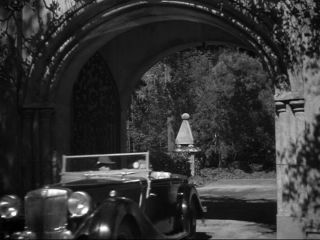The MacGuffin: News and Comment (30/Jun/2012)
(c) Ken Mogg (2012)
June 30
Revisiting Rebecca on DVD this week, it was impossible not to be impressed by the enormous craft of the filmmmakers. Of course, Rebecca is a Selznick film, and clearly Hitchcock learned a great deal from working with the memo-monarch on this, Hitchcock's first American film. It's to his credit that he didn't falter when Selznick chastised him for an unsuitable early draft of the screenplay, involving seasickness. The eventual film still has plenty of light and shade (quite literally), and Hitchcock 'touches', but they are raised to a new level of viewer-satisfaction because the filmmakers have respected certain constraints, both formal and to do with matters of characterisation. In no particular order, here are some observations. In terms of cinematography and design, the film is fascinating for its new professionalism, associated with the studio that had just made Gone With the Wind. Cinematography was by George Barnes, sets by Lyle Wheeler. When Maxim and 'I' arrive at Manderley after their honeymoon, they drive through an arched gateway which is part of the lodge-keeper's house (see frame-capture below). Both the architecture and the dappled light are suitably 'English' (Manderley, of course, is Maxim's ancestral home in Cornwall), and Selznick would have been well aware of such matters after producing Little Lord Fauntleroy (d. John Cromwell) four years earlier. But notice also that intriguing object in the background which looks like something that belongs more in a Peter Greenaway film than in one by Hitchcock! I have never found out just what it signifies - I even asked an author-friend in Cornwall about it once - but what I noticed this time around is how the object certainly isn't there randomly. When Maxim and 'I' arrive at the main house, there's a similar design - but larger - beside the steps leading up to the front door. And later, inside the house, the design is there too, incorporated this time into the pillars of Manderley's staircase. Another, related matter of cinematography and design I noticed this time is the film's almost 'subliminal' use of shadow-effects, again no doubt to give 'tone'. In the frame-capture from last week, notice the amorphous shadows above the row of caps on the wall behind Ben. There is no way of knowing what exactly the shadows represent - which is almost certainly intended. They are merely 'suggestive' (of people looking on, perhaps). Elsewhere in the film, similar effects are used. Sometimes they imply leaves on trees, though they aren't moving. (As I say, they are designed to work 'subliminally', and not to be questioned.) At other times, they are just 'interesting', perhaps filling a space or balancing a composition. Selznick seems to have loved such tapestry-filling (as Hitchcock himself would later call it), even when it became almost rococo in its elaborate use. In the brief scene where Maxim and 'I' are seen in a street outside a marriage bureau in France, do we really need the rows of pigeons near the doorway (both at ground-level and on the doorway's awning)? Answer: probably not, but they constitute a 'realistic' touch and give a further note of 'class' - and Hitchcock himself would later use the same 'effect' in Rear Window. Hitchcock's unique sense of what will entertain a viewer gets plenty of exercise in Rebecca, despite Selznick's wise insistence on fidelity to both the letter and spirit of Daphne du Maurier's novel. For example, Mrs Van Hopper (Florence Bates) is well characterised - she isn't just a gargoyle - and her grotesque loneliness is, after all, a pertinent variant on the loneliness of 'I' herself (an orphan) and that of her husband-to-be, Maxim (whose first wife had reportedly drowned). Well, on the DVD of Rebecca that I watched this week, actor Bruce Dern (Marnie, Family Plot) remembers Hitchcock telling him that Joan Fontaine (who plays 'I') and her sister Olivia de Havilland bitterly disliked each other. According to Dern, Hitchcock would have liked to have cast De Havilland as an extra in Rebecca, without telling her sister, and then to have brought them together unexpectedly while the cameras were rolling. Such 'mischief-making' on Hitchcock's part was part of his filmmaking mentality! It works perfectly for him in the scene where Mrs Van Hopper suddenly learns who Maxim intends to marry - namely, 'I'. Here the camera tracks into Mrs Van Hopper's face and the effect is almost as memorable as the first seagull attack in The Birds! Moreover, Maxim must suddenly hurry away. Immediately, Mrs Van Hopper shows another side of her personality, that of the injured viper. She tells 'I' what she thinks of her ('Mrs De Winter, indeed!'), then departs with as much dignity as she can summon up. Yet because the characterisation is convincing - and human - you almost feel sorry for her. As I say, I think Hitchcock learned a great deal from his time with Selznick, and especially when they were making Rebecca. To be continued.
This material is copyright of Ken Mogg and the Hitchcock Scholars/'MacGuffin' website (home page) and is archived with the permission of the copyright holder. |

